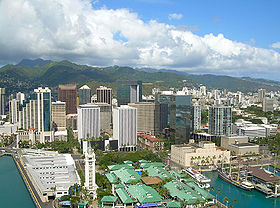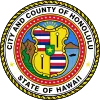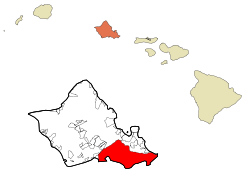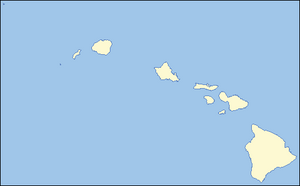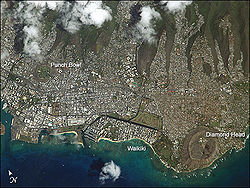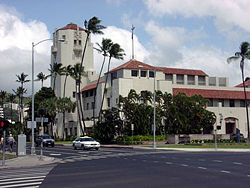Honolulu, Hawaii
| Honolulu, Hawaii | |||
| Aerial view of downtown from Honolulu Harbor | |||
|
|||
| Nickname: Crossroads of the Pacific, Sheltered Bay | |||
| Motto: Ha’aheo No ‘O Honolulu (Honolulu Pride)[1] | |||
| Location in Honolulu County and the state of Hawaii | |||
| Location in Hawaii | |||
| Coordinates: {{#invoke:Coordinates|coord}}{{#coordinates:21|18|32|N|157|49|34|W|type:city | |||
|---|---|---|---|
| name= }} | |||
| Country | United States | ||
| State | Hawaii | ||
| County | Honolulu | ||
| Government | |||
| - Mayor | Mufi Hannemann | ||
| Area | |||
| - CDP | 105 sq mi (272.1 km²) | ||
| - Land | 85.7 sq mi (222.0 km²) | ||
| - Water | 19.3 sq mi (50.1 km²) | ||
| Elevation | 0 ft (Sea Level 0 m) | ||
| Population (2000) | |||
| - CDP | 371,657 | ||
| - Metro | 909,863 | ||
| Time zone | Hawaii-Aleutian Standard Time (UTC-10) | ||
| Zip Code | 96801-96825 | ||
| Area code(s) | 808 | ||
| FIPS code | 15-17000 | ||
| GNIS feature ID | 0366212 | ||
| Website: http://www.honolulu.gov/ | |||
Honolulu is the capital and most populous census-designated place (CDP) in the U.S. state of Hawaii. Although Honolulu refers to the urban area on the southeastern shore of the island, the city and the county are consolidated, known as the City and County of Honolulu, and the city and county is designated as the entire island of Oahu.
Geography
In the Hawaiian language,Honolulu means "sheltered bay" or "place of shelter."
Honolulu extends about 10 miles (16km) along the southeast coast of the island of Oahu, and goes four miles (six kilometers) inland across a plain into the foothills of the Koolau Range. The closest location on the mainland of the United States to Honolulu is the Point Arena, California Lighthouse, at 2353 miles or (3787 kilometers).
Within Honolulu proper can be found several volcanic cones: Punchbowl, Diamond Head, Koko Head (includes Hanauma Bay), Koko Crater, Salt Lake, and Aliamanu being the most conspicuous.
While the city is clearly in the tropics, the climate (temperature and humidity) is moderated by its mid-ocean location, and has a warm semi-arid climate. The average maximum daytime temperature in January of 80°F (27°C), rising to an average maximum of around 88°F (31°C) in July. Temperatures exceed 90°F (32°C) only rarely, with lows in the 50's°F (15°C) occurring perhaps once or twice in a year. Mean annual precipitation is 22 inches (558mm).
The city-county covers an area of 597 square miles (1545 square kilometers) and comprises all of Oahu and some outlying islets.
Most of the city's commercial and industrial developments are located on a narrow but relatively flat coastal plain, while numerous ridges and valleys located inland of the coastal plain divide Honolulu's residential areas into distinct neighborhoods: some spread along valley floors (like Manoa in Manoa Valley) and others climb the interfluvial ridges.
Downtown Honolulu is the financial, commercial, and governmental center of Hawaii. On the waterfront is Aloha Tower, which for many years was the tallest building in Hawaii. Currently the tallest building is the 438-foot (134 m)-tall First Hawaiian Center, located on King St and Bishop St.
Kakaako is a light-industrial district between Downtown and Waikīkī that has seen a large-scale redevelopment effort in the past decade. It is home to two major shopping areas, Ward Warehouse and Ward Centre.
Waikiki is the world famous tourist district of Honolulu, located between the Ala Wai Canal and the Pacific Ocean next to Diamond Head. Numerous hotels, shops, and nightlife opportunities are located along Kalakaua Ave and Kuhio Ave. World-famous Waikīkī Beach attracts millions of visitors a year. Just west of Waikīkī is Ala Moana Center, the world's largest open-air shopping center.
Aloha Stadium, Pearl Harbor (with the USS Arizona Memorial), and Hickam Air Force Base are located in the island's Ewa District.
History
It is not known when Honolulu was first settled by the original Polynesian migrants to the archipelago. Oral histories and artifacts indicate that there was a settlement where Honolulu now stands in the 12th century. However, after Kamehameha I conquered Oʻahu in the Battle of Nuʻuanu at Nuʻuanu Pali, he moved his royal court from the Island of Hawaiʻi to Waikīkī in 1804. His court later relocated, in 1809, to what is now downtown Honolulu.
Captain William Brown of England was the first foreigner to sail, in 1794, into what is now Honolulu Harbor. More foreign ships would follow, making the port of Honolulu a focal point for merchant ships traveling between North America and Asia.
In 1845, Kamehameha III moved the permanent capital of the Hawaiian Kingdom from Lahaina on Maui to Honolulu. He and the kings that followed him transformed Honolulu into a modern capital, erecting buildings such as St. Andrew's Cathedral, ʻIolani Palace, and Aliʻiōlani Hale. At the same time, Honolulu became the center of commerce in the Islands, with descendants of American missionaries establishing major businesses in downtown Honolulu.
Despite the turbulent history of the late 19th century and early 20th century, which saw the overthrow of the Hawaiian monarchy, Hawaiʻi's subsequent annexation by the United States, and the Japanese attack on Pearl Harbor, Honolulu would remain the capital, largest city, and main airport and seaport of the Hawaiian Islands.
An economic and tourism boom following statehood brought rapid economic growth to Honolulu and Hawaiʻi. Modern air travel would bring thousands, eventually millions (per annum) of visitors to the Islands. Today, Honolulu is a modern city with numerous high-rise buildings, and Waikīkī is the center of the tourism industry in Hawaiʻi, with thousands of hotel rooms.
Government
eastbound into Honolulu CDP]]
The state government of Hawaii is modeled after the U.S. federal government with adaptations originating from the kingdom era of Hawaiian history. The Governor of Hawaii and assisted by the lieutenant governor, both elected. The Hawaii State Senate comprises 25 members, and the Hawaii State House of Representatives comprises 51 members.
Honolulu is administered under a consolidated city-county form of government employing a strong mayor-council system. The Mayor of Honolulu holds executive privilegesTemplate:Mdashas opposed to mayors with only ceremonial powersTemplate:Mdashand the Honolulu City Council serves as the legislature. The mayor and city council administer the Honolulu Fire Department and Honolulu Police Department through appointed officials.
Like most cities in the United States, the City and County of Honolulu is divided into smaller administrative districts. There are nine such districts, each of which elects a member of the city council. The boundaries of each district are revised every ten years in conjunction with the U.S. Census. Each district is composed of unincorporated subdivisions unofficially called towns and cities.
The official seat of governance for the City and County of Honolulu is located within the district at Honolulu Hale, established in the 1920s as a city hall structure and houses the chambers of the Mayor of Honolulu and the Honolulu City Council.
Economy
Honolulu is the crossroads of trans-Pacific shipping and air routes, the focus of inter-island services, and the commercial and industrial centre of the state.
The median income for a household in the CDP was $45,112, and the median income for a family was $56,311. Males had a median income of $36,631 versus $29,930 for females. The per capita income for the CDP was $24,191. About 7.9% of families and 11.8% of the population were below the poverty line, including 14.6% of those under the age of 18 and 8.5% of those 65 and older.
Financial and business services sector Tourism Manufacturing
Several freeways and highways link Honolulu proper with other parts of the Island of Oahu. The Honolulu metropolitan area experiences heavy traffic congestion during rush hours
Located on the western end of Honolulu proper, Honolulu International Airport is the principal aviation gateway to the state of Hawaii. Honolulu has the principal port of Hawaii
Dubbed "America's Best Transit System" for three years, Honolulu's TheBus system operates 107 routes serving Honolulu and outlying areas on Oahu with a fleet of 531 buses.
There is no urban rail transit system in Honolulu, although electric street railways were once used. After 20 years of political maneuvering, in 2008, the residents of Honolulu voted to continue developing a rail project for electric trains approximately 200 feet long, capable of carrying more than 300 passengers.
Demographics
The population of the census designated place was 371,657 at the 2000 census, while the combined population of the city and county was 909,863.
The racial makeup was 19.67 percent White, 1.62 percent Black or African American, 0.19 percent Native American, 55.85 percent Asian, 6.85 percent Pacific Islander, 0.89 percent from other races; and 14.93 percent from two or more races. Hispanic or Latino of any race were 4.37 percent of the population.
Language
Religion
Colleges and universities in the Honolulu community include University of Hawaii at Manoa, Chaminade University, and Hawaii Pacific University.
Hawaii Department of Education operates public schools in Honolulu.Punahou School , Kalani High School and President Theodore Roosevelt High School serve the Honolulu community.
Cultural institutions
Performing arts
Established in 1900, the Honolulu Symphony is the oldest US symphony orchestra west of the Rocky Mountains. Other classical music ensembles include the Hawaii Opera Theatre. Honolulu is also a center for Hawaiian music. The main music venues include the Neal Blaisdell Center Concert Hall, the Waikiki Shell, and the Hawaii Theatre.
Honolulu also includes several venues for live theater, including the Diamond Head Theatre.
Visual arts
There are various institutions supported by the state and private entities for the advancement of the visual arts. The Honolulu Academy of Arts is endowed with the largest collection of Asian and Western art in Hawaii. It also has the largest collection of Islamic art, housed at the Shangri La estate. The academy hosts a film and video program dedicated to arthouse and world cinema in the museum's Doris Duke Theatre, named for the academy's historic patroness Doris Duke.
The Contemporary Museum is the only contemporary art museum in the state. It has two locations: main campus in Makiki and a multi-level gallery in downtown Honolulu at the First Hawaiian Center.
The Hawaii State Art Museum is also located in downtown Honolulu at No. 1 Capitol District Building and boasts a collection of art pieces created by local artists as well as traditional Hawaiian art. The museum is administered by the Hawaii State Foundation on Culture and the Arts.
Natural museums
Recognized internationally as the premier cultural institution of Hawaii, the Bishop Museum is the largest of Honolulu's museums. It is endowed with the state's largest collection of natural history specimens and the world's largest collection of Hawaiiana and Pacific culture artifacts. The Honolulu Zoo is the main zoological institution in Hawaii while the Waikiki Aquarium is a working marine biology laboratory. The Waikiki Aquarium is partnered with the University of Hawaii and other universities worldwide. Established for appreciation and botany, Honolulu is home to several gardens: Foster Botanical Garden, Liliuokalani Botanical Garden, Walker Estate, among others.
Sports
Currently, Honolulu has no professional sports teams. However, Honolulu hosts the NFL's annual Pro Bowl each February in addition to the NCAA football Hawaii Bowl. Honolulu also supports the Hawaii Winter League annually from late September to late November, hosting minor league players from MLB, NPB, and Korea. Games are hosted at Les Murakami and Hans L'Orange Park. Fans of spectator sports in Honolulu generally support the football, volleyball, basketball, and baseball programs of the University of Hawaii at Manoa. High school sporting events, especially football, are especially popular. Venues for spectator sports in Honolulu include:
- Les Murakami Stadium at UH-Manoa (baseball)
- Stan Sheriff Center at UH-Manoa (basketball and volleyball)
- Neal Blaisdell Center Arena (basketball)
Aloha Stadium, a venue for American football and soccer (football), is located in nearby community of ʻAiea.
Honolulu's mild climate lends itself to year-round fitness activities as well. In 2004, Men's Fitness magazine named Honolulu the fittest city in the U.S. Honolulu is also home to three large road races:
- The Great Aloha Run is held annually on Presidents' Day.
- The Honolulu Marathon, held annually on the second Sunday in December, draws more than 20,000 participants each year, about half to two thirds of them from Japan.
- The Honolulu Triathlon is an Olympic distance triathlon event governed by USA Triathlon. Held annually in May since 2004, there is an absence of a sprint course.
Former professional franchises
- Hawaii Islanders (Pacific Coast League, 1961-1987)
- Hawaiian Islanders (af2, 2002-2004)
- Team Hawaii (North American Soccer League, 1977)
- The Hawaiians (World Football League, 1974-1975)
Media
Tourist attractions
- Ala Moana
- Aloha Tower
- Bishop Museum
- Diamond Head
- Hanauma Bay
- Honolulu Academy of Arts
- ʻIolani Palace
- Lyon Arboretum
- National Memorial Cemetery of the Pacific
- USS Arizona Memorial
- Waikiki Aquarium
- Waikiki Beach
- See also: Oahu
Gallery
- Honolulu port.jpg
View of Honolulu from an aircraft departing from Honolulu International Airport
- Honoluluviewfromhnlairport.JPG
View of Honolulu skyline from Honolulu International Airport
ReferencesISBN links support NWE through referral fees
- ↑ "Events, Official Web Site for The City and County of Honolulu." City and County of Honolulu. Accessed October 14, 2008.
External links
- Travel guide to Honolulu, Hawaii from Wikitravel
- Encyclopaedia Britannica Honolulu Retrieved December 1, 2008.
- City and county of Honolulu Retrieved December 1, 2008.
Credits
New World Encyclopedia writers and editors rewrote and completed the Wikipedia article in accordance with New World Encyclopedia standards. This article abides by terms of the Creative Commons CC-by-sa 3.0 License (CC-by-sa), which may be used and disseminated with proper attribution. Credit is due under the terms of this license that can reference both the New World Encyclopedia contributors and the selfless volunteer contributors of the Wikimedia Foundation. To cite this article click here for a list of acceptable citing formats.The history of earlier contributions by wikipedians is accessible to researchers here:
The history of this article since it was imported to New World Encyclopedia:
Note: Some restrictions may apply to use of individual images which are separately licensed.
